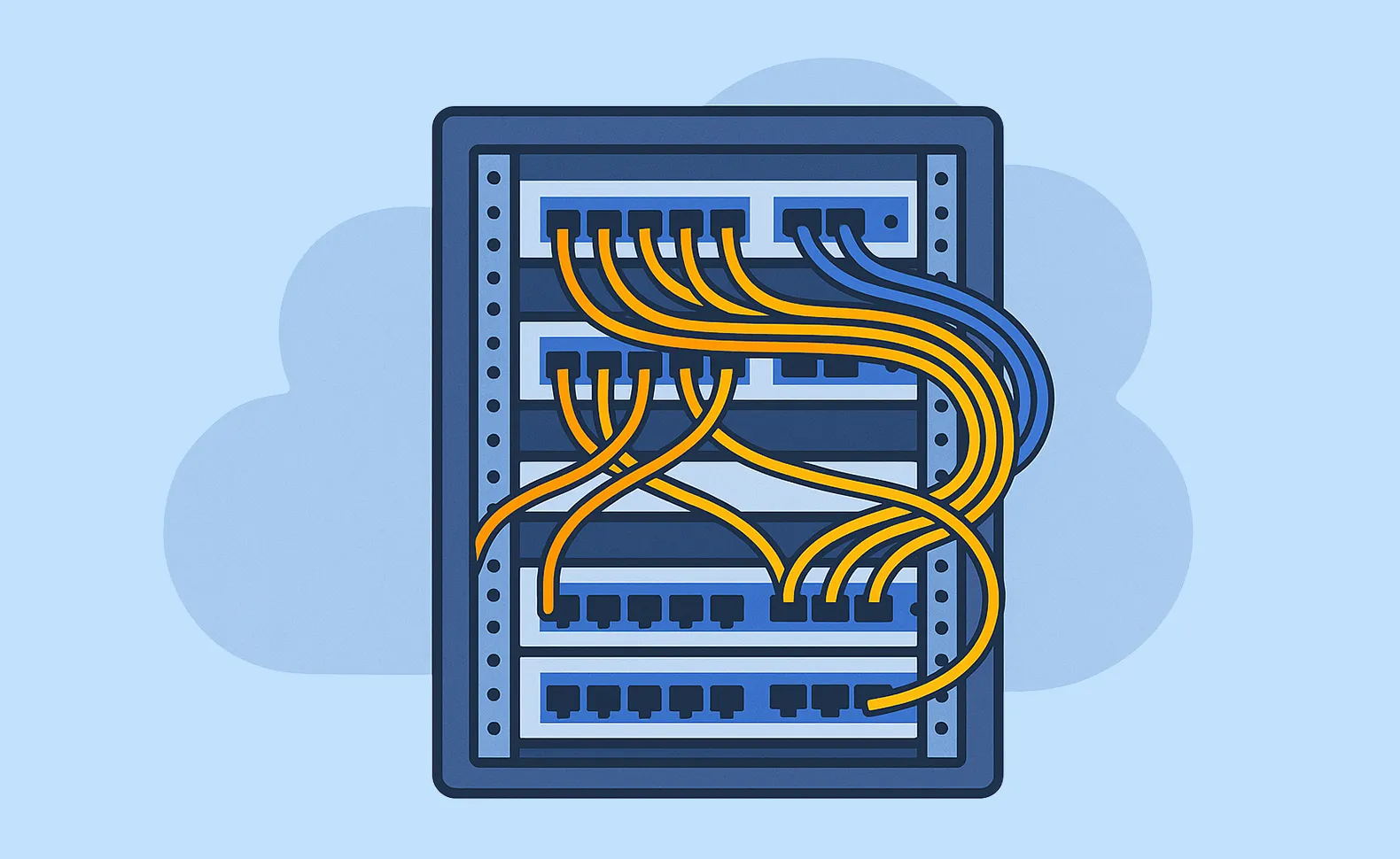The most important thing in brief:
- Network cabinet cabling describes the structured connection and arrangement of all IT components in a server rack. The aim is a secure, maintainable and scalable operation of the network environment.
- Step-by-step guide: In this way, patch panels, switches, cable routing and documentation are optimally implemented.
- Includes documentation template for structured recording of ports, IPs, VLANs and devices to meet ISO 27001 and GDPR requirements.

The correct Network cabinet cabling ensures overview, operational reliability and scalability. But what is behind this term? Why is well-thought-out cabling necessary — and what can go wrong with poor planning?
This article provides answers to the following questions:
- What does network closet cabling mean and why is it relevant?
- How can structured cable management implement in the server rack?
- How does a solid support Network closet documentation Maintenance and safety?
- What are the benefits of the software Docusnap when documenting?
- What are the typical mistakes to avoid when cabling?
What does network closet cabling mean?
Network cabinet cabling describes the structured arrangement and connection of all network components within a server cabinet. The aim is to create a functional, maintainable and secure network environment.
The term includes:
- patch panel cabling
- Connect switches, servers, and power strips
- Cable routing (horizontal/vertical)
- Labeling and documentation of all ports and devices
Without a clear structure, messy cabling quickly leads to problems: signal faults, overheating, lengthy fault diagnoses and/or security gaps.
Why structured cabling is necessary
A structured Cabling in the network cabinet brings many benefits:
1. Maintainability
Errors can be localized more quickly and changes can be made more efficiently.
2. Scalability
A neatly wired cabinet is easy to expand — without too much cable clutter.
3. Safety & compliance with standards
Professional cable management helps to comply with fire protection and IT security guidelines (e.g. ISO/IEC 27001 or DIN EN 50174).
4. Documentation requirements
Especially in regulated industries (e.g. medicine, finance), a complete Network closet documentation often mandatory. The basis for this is, among others, the ISO/IEC 27001 for information security management systems, DIN EN 50600 for data centers and industry-specific regulations such as KRITIS regulation (IT-SiG) or requirements in accordance with BaFin (e.g. BAIT, VAIT).
Basics of cable management in a server rack
Before laying the first cables, the following points should be clarified:
1. Planning
- Which devices are stored in the cabinet?
- Which ports and services are required?
- Are there redundancy or fail-safe requirements?
Cable lengths & types
- Standardised lengths (e.g. 0.5 m, 1 m, 2 m) improve organization
- Use shielded twisted pair cables (such as Cat 6a)
- Spatially separate power and network cables
cable routing
- Horizontal: through cable management panels (1—2 U)
- Vertical: through lateral cable channels
Step-by-step guide: Wiring a network cabinet
1. Install the patch panel and switches
A well-structured network cabinet starts with the correct placement of the main components. If possible, the patch panel should be mounted at the top of the cabinet, as it primarily acts as a passive connecting element. Switches can be placed directly below to enable short, clear patch cable connections. Active devices such as servers or storage systems can be stored in the lower third — this improves both accessibility and weight distribution in the rack.
Checklist: Placement of main components
- Install the patch panel at the top
- Place switches directly below the patch panel
- Install active devices (such as servers) in the lower third of the rack
- Pay attention to symmetrical weight distribution
- Ensure air circulation through free space above and below appliances
2. Group devices logically
Structure is created not only by hardware arrangement, but also by functional grouping. Network components can be sorted by building parts, departments or types of use (data, telephony, WLAN), for example. Color-coded patch cables help to keep track of things: blue for data connections, red for VoIP telephony, yellow for management access. This system facilitates both maintenance and expansion.
To-dos for functional grouping:
- Define network zones (e.g. administration, production, guests)
- Logically arrange components in the rack (e.g. VoIP switch next to VoIP patch panel)
- Define and consistently apply the color code system
- Color code patch cables according to function or use
- Implement lettering consistently and legibly (e.g. with a labeling device)
3. Insert and label cables
When retracting the patch cables, ensure a sufficient bend radius and good strain relief. Too tight bends or tensioned cables lead to failures sooner or later. Each end of the cable should be neatly and permanently labelled — with location identification and port number, for example. In this way, connections can be clearly identified at any time, even during subsequent modifications or audits.
To-dos when retracting and labeling the cables:
- Route cables with enough clearance to avoid tension
- Maintain bend radii, particularly for copper and fiber optic cables
- Check all cables for the correct length before installation
- Apply lettering on both sides (patch panel and target page)
- Use a uniform, durable labeling system (e.g. with a label printer)
4. Use cable routing
Cable clutter can be avoided by consistently using cable routing elements. Compared to classic cable ties, Velcro tapes have the advantage that they are reusable and gentle on cable insulation. Cables should always be routed along the intended guides and never run across device fronts or ventilation slots. This not only protects the hardware, but also supports airflow in the rack.
To-Dos for effective cable management:
- Plan horizontal and vertical cable routing in the rack
- Use velcro straps instead of zip ties
- Check cable routing elements regularly for load
- Bundle cables by functional group (e.g. data, power)
- Keep airflows clear, especially with active devices
5. Create documentation
An essential part of any professional wiring is the comprehensive documentation. All connections — from port to port — are systematically recorded. In addition, IP addresses, MAC addresses and the associated device locations should be noted. It is particularly helpful to compare the patch panel configuration with the switch ports — ideally in tabular or graphical form. Such documentation enables quick troubleshooting, easy extensions and meets regulatory requirements.
To-Dos for complete network cabinet documentation:
- Number and record all patch panel and switch ports
- Note connections between ports (including target devices)
- Document IP/MAC addresses of the end devices
- Record location information from connected devices
- Uniquely mark VLAN assignments
- Update and version documentation regularly
- Create a graphical overview or rack diagram
Case study: When poor cabling becomes expensive
In a logistics center with several warehouse and administrative locations, there are regular disconnections between barcode scanners and VoIP telephones. The cause is a network closet that has grown over the years without continuous documentation. Patch cables run uncoordinated, and duplicate connections and unused ports make troubleshooting difficult. When a technical defect causes central warehouse control to fail, the cause is only identified after several hours.
The result of the failure is serious: The entire warehouse logistics is at a standstill for several hours, delivery times are delayed, and order pickings must be manually documented. The company is experiencing production interruptions, delivery delays and a temporary backlog in outgoing goods. The costs incurred — including additional work for the IT team, downtime of processes and contractual penalties due to missed delivery deadlines — add up quickly. Reputational damage among business partners is usually added.
Legal & safety-related aspects
A proper Network cabinet wiring is not only technically necessary — it is also legally relevant:
- safety regulations (e.g. VdS 2007, DIN 4102, DIN EN 50600) require orderly cable routing in order to minimize fire loads and ensure operational safety in IT environments. Properly laid and marked cables can be identified and switched off more quickly in the event of a fire or technical defect, which can reduce property and personal injury.
- Die GDPR requires technical and organizational measures (TOM) to protect personal data — this includes the transparent and comprehensible structure of networks. Unexplained cable connections or missing network plans can be considered a defect during audits.
- For certifications like ISO/IEC 27001 (information security) or TISAX (automotive industry), up-to-date IT documentation is mandatory. It comprises the network topology, physical infrastructure and seamless traceability of changes. Without structured cabling and documentation, these requirements can hardly be met.
Network closet documentation & template
A comprehensive network closet documentation template ideally contains:
- Rackplan (position of all devices)
- Patch panel and switch port configurations
- IP/MAC addresses
- VLAN assignments
- Topology diagrams
A practical template for network closet documentation typically includes the following content:
- Name of the network cabinet (e.g. location, ID)
- Overview of all installed components (patch panel, switches, servers)
- Port plans with patch panel and switch port assignment
- Color coding of cable types and their functions
- IP address and MAC address lists
- VLAN assignments
- graphical rack displays for better orientation
- Change log with time stamp and person responsible
A structured template format not only saves time, but also ensures consistency and traceability over the entire life cycle of a network cabinet.
Docusnap: The solution for IT documentation & cable management
The software Docusnap offers complete IT documentation, network inventory and visualization — ideal not only for mapping network cabinet cabling.
The benefits of Docusnap at a glance:
- Automatic scans: Detects devices, ports, IPs, VLANs, and more
- visualizing: Automatically creates rack diagrams, topologies, and network plans
- documentation: Uses structured templates, including network cabinet documentation
- version control: Changes are historicized
Docusnap can be used flexibly — both for individual racks and for complex IT landscapes.
Common cabling mistakes — and how to avoid them
- Tangled cables: Use cable routings consistently, bundle cables neatly and group them by function
- Missing label: Identify each port and cable clearly, ideally with permanent lettering on both sides
- Unnecessarily long cables: Plan cable lengths precisely in advance, ensure appropriate standard lengths and do not “roll up” any cables
- No documentation: Capture all connections, devices, and address data — e.g. with automated tools such as Docusnap
- Mixed installation of power and data lines: provide separate routes to avoid electromagnetic interference
- Blocked airflows: Do not run cables in front of ventilation inlets and outlets to prevent overheating
- Lack of redundancy planning: Critical systems without backup lines pose failure risks — consider reliability
Conclusion: Structured network cabinet cabling as the basis of every IT
A well-thought-out Cabling in the network cabinet brings order, security and efficiency to the IT infrastructure. With clear planning, structured implementation and professional documentation, failures can be avoided, maintenance costs reduced and legal requirements met.
Regardless of whether existing installations are being replanned or optimized — tools such as Docusnap significantly simplify IT documentation and cable management.
Next steps:
Clean planning, followed by clear cable routing and complete documentation, is recommended for structured implementation. With Docusnap, networks can be automatically recorded, graphically displayed and sustainably documented — including rack visualization, port and IP allocation. A 30-day free trial is the ideal way to start enjoying the benefits right away.
Jetzt testen


